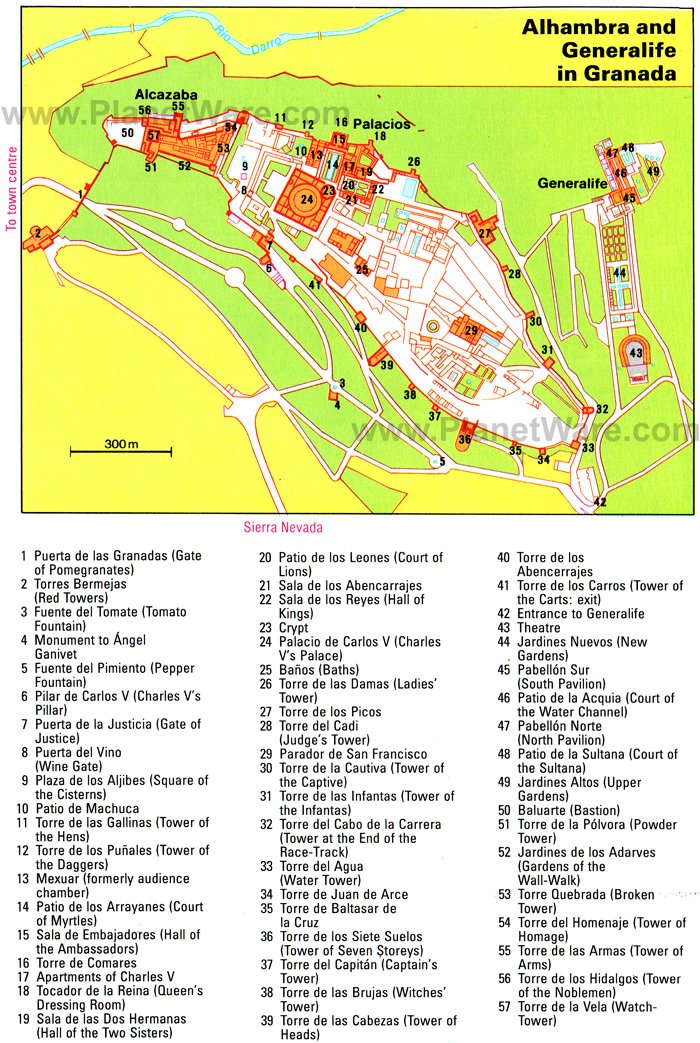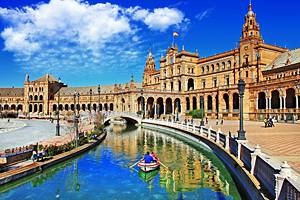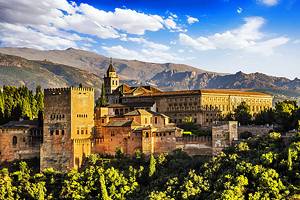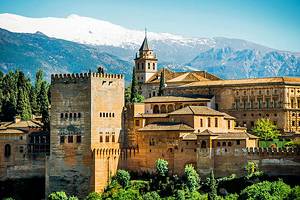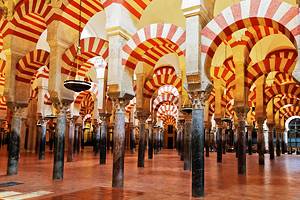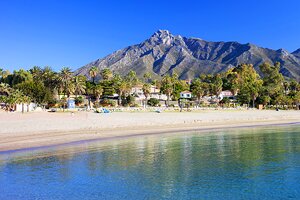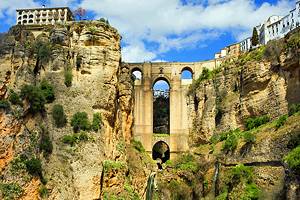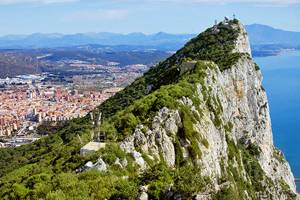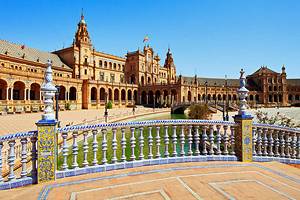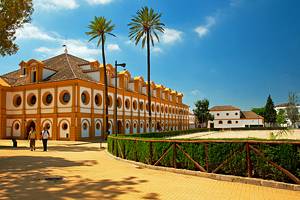Visiting the Alhambra: 12 Top Attractions
The lush landscape of the Alhambra in Granada was like heaven on earth for the Moors, who arrived here from the deserts of North Africa beginning in the 13th century. Majestic snowcapped Sierra Nevada Mountains provide a gorgeous backdrop and the source of the Río Genil. This pristine, flowing freshwater became a symbol of abundance.
An oasis of dancing fountains, tall trees, and fragrant flowers, the Alhambra enjoys an awe-inspiring natural setting. The luxuriant grounds seem perfectly suited for lavish Moorish palaces.
Known in Arabic as Medinat al-Hamra, the ''Red City,'' because of the color of the stone buildings, the Alhambra is a breathtakingly romantic sight. This citadel, with its complex of palaces, is one of the best places to visit in Andalusia to admire Islamic architecture. The intricately decorated rooms and serene courtyards represent the finest achievements of Moorish art in the world.
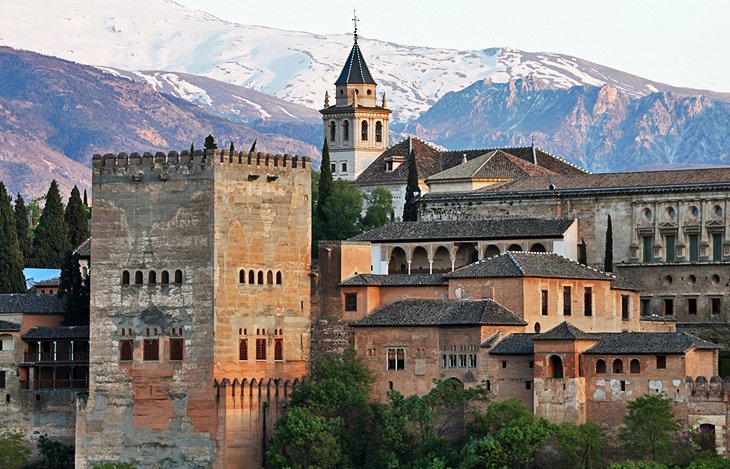
The artistic splendor of the Alhambra finds its finest expression at the Palacios Nazaries, built for Mohammed ben Al-Hamar in the 13th century, and home of the Nasrid Dynasty of Sultans until the 15th century. These splendid Nasrid Palaces are the glory of the Alhambra, their exquisite interiors filled with ornately decorative Islamic tiling and stucco work.
Beautifully laid out in three sections, the Palacios Nazaries are made up of the Palacio Real (Royal Palace), the Palacio de Comares (Palace of Ceremonial Rooms), and the Palacio de los Leones (Palace of the Lions, which was the Sultan's private quarters). In each section, all the rooms open onto a central courtyard in typical Andalusian style.
Because of its extraordinary cultural value, the Alhambra complex is a designated UNESCO World Heritage Site. This vast fortified complex also includes the striking Palacio de Carlo V; the luxuriant Generalife Gardens; and the Alcazaba ruins, with breathtaking views over the city.
Read our list of the top attractions at the Alhambra, so that you can plan your visit and make the most of your experience.
- Mexuar
- Patio de los Arrayanes (Court of Myrtles)
- Torre de Comares (Comares Tower)
- Sala de los Embajadores (Hall of the Ambassadors)
- Sala de Barca (Hall of the Blessing)
- Patio de los Leones (Court of Lions)
- Sala de las dos Hermanas (Hall of the Two Sisters)
- Sala de los Reyes (Hall of the Kings)
- Sala de los Abencerrajes
- Alcazaba: Ruins of the 13th-Century Moorish Castle
- Palacio de Carlos V (Palace of Charles V)
- Generalife Gardens
- How to Make the Most of Your Visit to the Alhambra
- Map of the Alhambra: Top Attractions
Mexuar
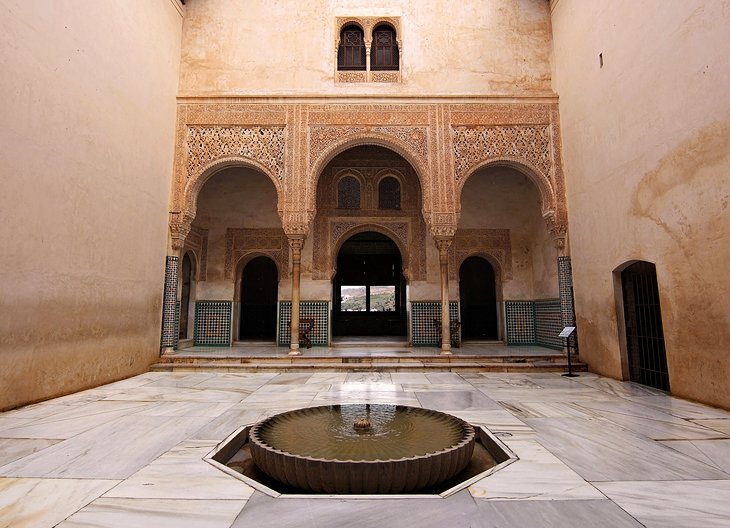
The oldest part of the Nasrid Palaces, this section is also the most changed by later uses. The azulejo-clad audience chamber and courtroom was used for the public administration of justice and for large assemblies.
After the Christian conquest, this space was used as a chapel, and you can see the balustraded balcony that was once the choir.
On the left of the adjoining Patio del Mexuar is the Cuarto Dorado (Golden Chamber), which features one of the finest facades of this Alhambra palace. This area is all that remains of the Palacio Real; the other rooms of this palace were destroyed by Yúsuf I or his son Muhammad V.
Patio de los Arrayanes (Court of Myrtles)

The Patio del Mexuar leads into the Patio de los Arrayanes, also called the Patio de los Mirtos because of the hedges of myrtle around the central pond. This spacious courtyard features graceful arcades at each end, as well as two fountains, which feed the pond. Most of the inscriptions around the patio are praises to God.
The courtyard's white marble patio encloses a pond, which reflects the building's facade in its placid waters. The parapet above the northern gallery reflects in the pool on a clear day, making a lovely photo op.
Torre de Comares (Comares Tower)
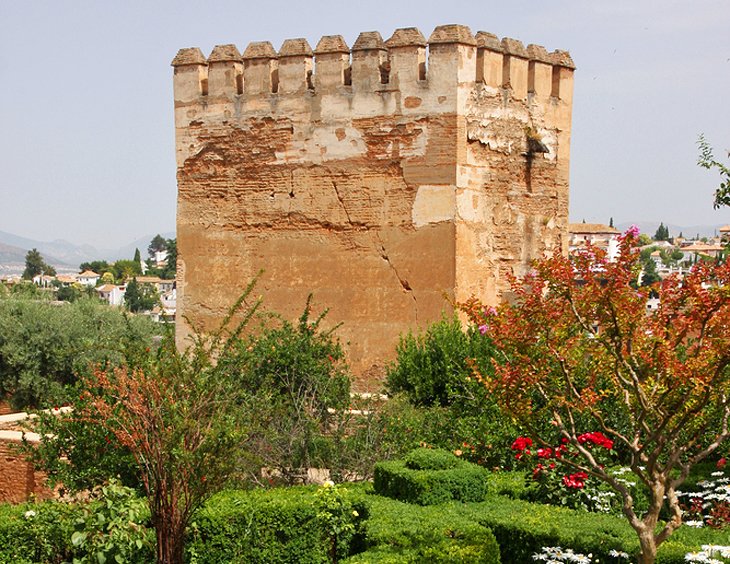
Between the walls of the Sala de la Barca and the adjoining hall is a narrow passage with two doors, and the left door leads to the higher chambers of the tower. The Torre de Comares is the tallest of the remaining towers of the Alhambra. It's named for the stained-glass windows of the balconies called "comarías," which illuminate the grand hall inside the tower.
The tower offers splendid views of the landscape. It is said that Boabdil, the last Moorish ruler of Granada, negotiated his surrender to the Catholic Monarchs here after taking in a final glimpse of the beautiful scenery.
Sala de los Embajadores (Hall of the Ambassadors)
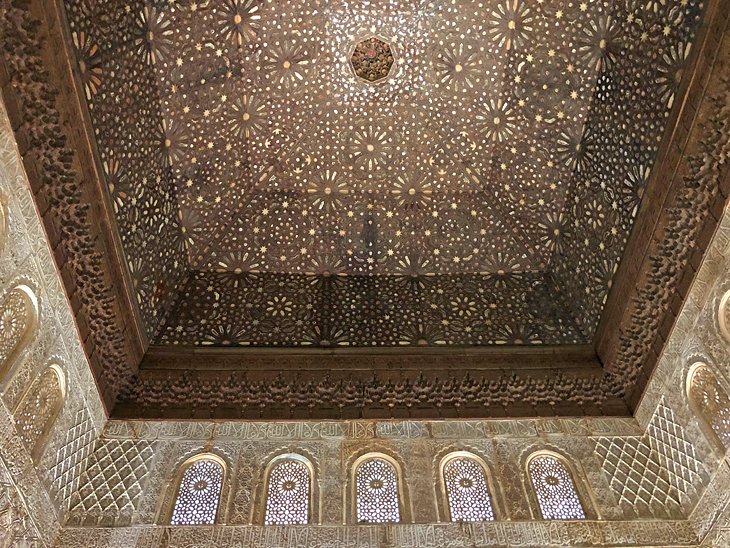
Inside the Torre de Comares, the Sala de los Embajadores is one of the most exquisite rooms in the Alhambra. It was a throne room and where the rulers of Granada received foreign envoys. A magnificent larch-wood dome and the multitude of tall windows give the space an ethereal quality.
The most striking feature of the decor is its profusion of ornamentation, with more than 150 different patterns, including verses from the Koran, floral details, and geometric themes.
Sala de Barca (Hall of the Blessing)
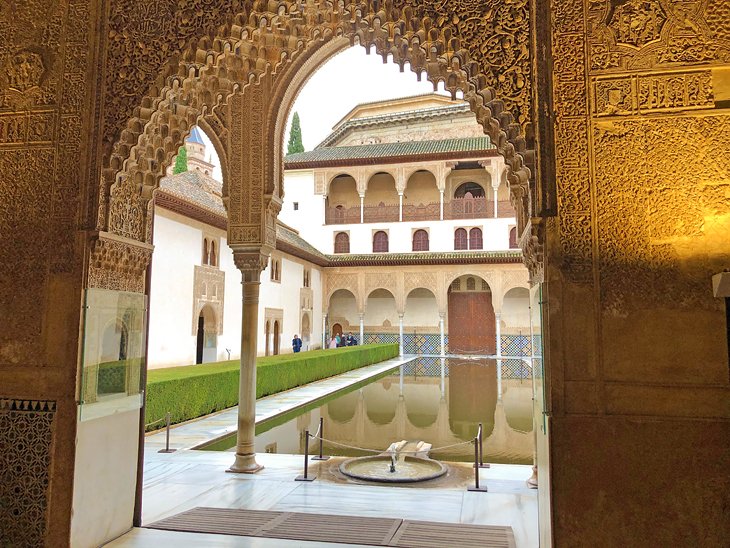
This hall is also inside the Torre de Comares. The origin of its name is the Arabic word baraka, which means blessing but degenerated into the Spanish word barca, which means boat.
The rectangular hall is 24 meters long by 4.35 meters wide but was originally smaller and later extended by Mohammed V. A semi-cylindrical vault was destroyed by a fire in 1890 and replaced by a copy completed in 1964.
The walls feature plasterwork with the Nasrid coat of arms including the word "Blessing" and the dynasty's motto "Only God is Victor."
Patio de los Leones (Court of Lions)

From the southeast corner of the Court of Myrtles, a path leads through the Sala de los Mozárabes into the Patio de los Leones. This patio is the central feature of the Palacio de los Liones, the royal winter residence built by Mohammed V, with the adjoining Harem.
In the center of this spacious court is the famous Lion Fountain, which features twelve marble lions. Around the courtyard, the arcading, with its 124 columns, has an extraordinary sense of lightness and delicacy.
Water features flow through intricately carved channels in the blindingly-white marble floor, the gentle tinkling give the patio a calm and relaxing feel.
Sala de las dos Hermanas (Hall of the Two Sisters)

On the north side of the Court of Lions, the Sala de las Dos Hermanas, along with the adjoining apartments, provided lodging for the women of the palace.
The incredibly ornate tile work and stucco decoration is among the finest in the entire Alhambra. A dazzling honeycomb dome represents a remarkable work of Arab stalactitic vaulting, with thousands of intricate details.
The hall is called the "two sisters" because of the two large identical slabs of marble in the floor.
Sala de los Reyes (Hall of the Kings)
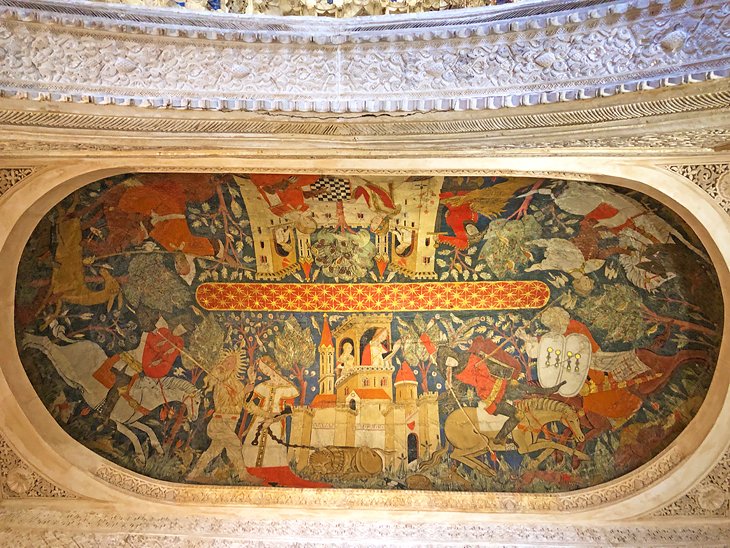
At the east end of the Court of Lions is the Sala de los Reyes or Sala de la Justicia (Hall of Justice). This hall is divided into seven sections with soaring stalactitic domes.
In its alcove-like recesses are wonderfully preserved 15th-century ceiling paintings. Most noteworthy are the three rare paintings on leather depicting scenes of court life and portraits of rulers.
One painting shows ten magnificently attired councillors, another is a hunting scene, and the third features the rescue of a maiden from the clutches of a wild man.
Sala de los Abencerrajes
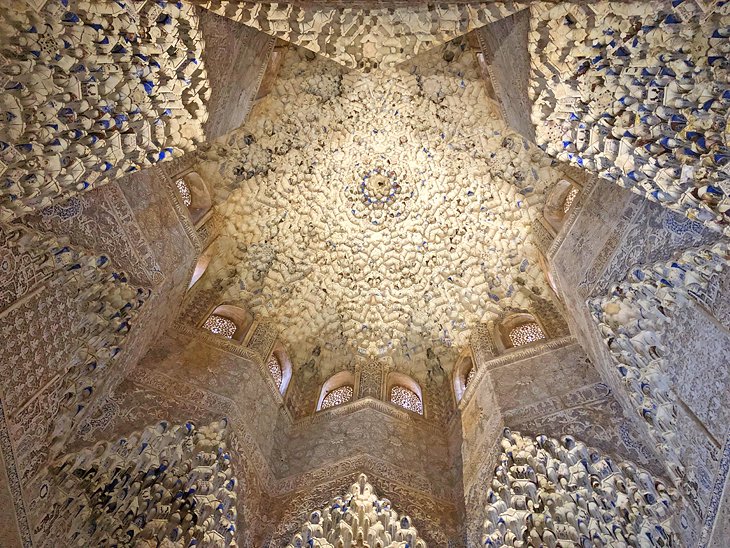
On the south side of the Court of Lions is the impressive Sala de los Abencerrajes. Legend says that the hall was named for the Abencerrajes knights, who were reputedly beheaded in this ornate room.
A mighty stalactitic ceiling dome is the most striking feature of this ornately adorned hall. Written on the dome's pedentives is the inscription: "There is no other help than the help that comes from God, the clement and merciful One."
In the center of the room, beneath the dome, is a twelve-sided marble fountain. Look carefully, and you might be able to see a rusty stain on the fountain, which is said to be blood from the Abencerrajes knights.
Alcazaba: Ruins of the 13th-Century Moorish Castle
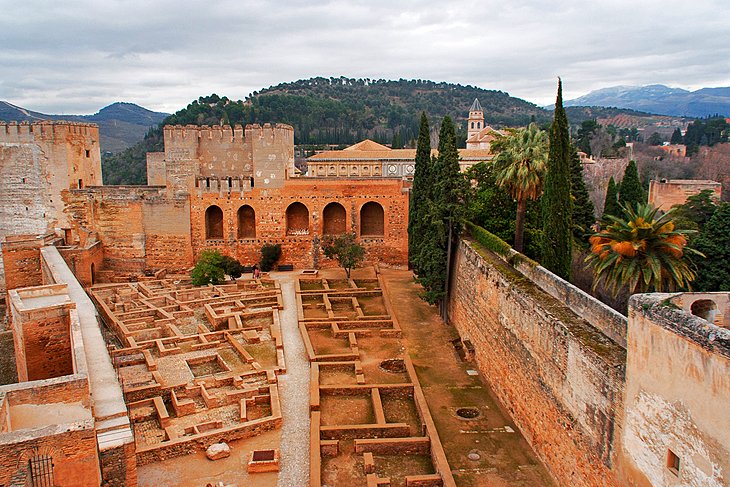
The Alcazaba is the original 13th-century Moorish fortress. This royal castle was built during the reign of Mohammed I. All that remains are the outer walls with their massive towers, but you will still enjoy exploring the ruins and walking around the ramparts to take in panoramic views.
From the vantage point of the old walls, you can see the Plaza Nueva, the Albaicín, and the Sierra Nevada mountains in the distance.
The best views are from the 26-meter-high Torre de la Vela (tower) at the west end of the terrace. The ascent to the top is not for the faint of heart or for those afraid of closed in spaces. It's narrow, steep and a relatively tough workout to get to the top.
The Puerta de la Alcazaba leads into the Jardín de los Adarves, a lovely shaded garden on the south side of the castle. Here you'll find tinkling fountains, pleasant walkways and sensational views of Granada.
Palacio de Carlos V (Palace of Charles V)
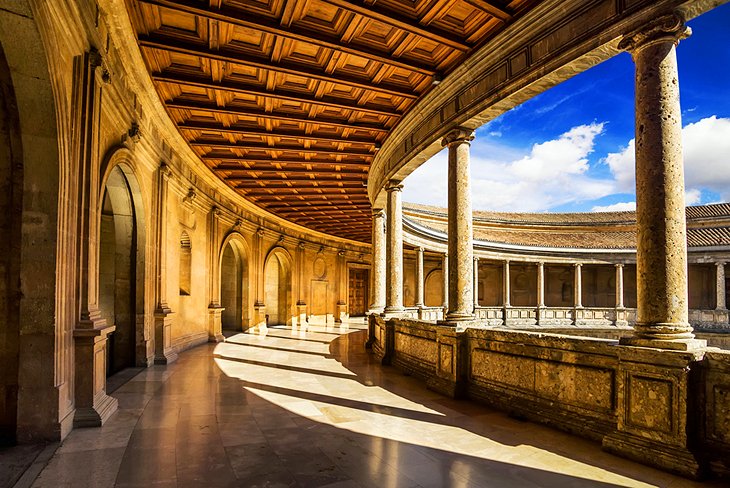
A striking architectural contrast to the Islamic style of the other Alhambra palaces, the Palacio de Carlos V was built after the Christian Reconquest. This monumental palace, a massive structure 63 meters square and 17 meters high, was created for Emperor Charles V by Pedro Machuca.
Begun in 1526 but never completed, the palace was designed on a grandiose scale to rival the Moorish palaces and paid for by a special tax imposed on Moors who had remained in Granada after its Reconquest.
Even in its unfinished state, this palace is the finest example of High Renaissance architecture in Spain. The building has an extravagant facade and an impressive inner courtyard with a pillared two-story rotunda of Doric columns in the lower gallery and Ionic columns in the upper gallery.
The top floor of the palace houses the Museo de Bellas Artes de Granada (Fine Arts Museum), which has an excellent collection of European paintings from the 15th century to the 20th century. Most of the collection represents religious paintings that were created from the 16th century to 18th century at the monasteries of Granada.
On the ground floor (south side) of the palace is the Museum of the Alhambra, the best collection of Spanish-Moorish and Nasrid art in Spain. The museum presents the history and art of the (Nasrid dynasty) Caliphate, including Islamic-style plasterwork, marble columns, and ceramics. Not to be missed is the "Vase of the Gazelles," an exemplary piece of Spanish-Moorish ceramic art.
If it's hot and busy, the Palacio de Carlos V is a great spot to escape the sun and crowds. Its open-air areas are rarely busy and have extensive shade cover, the smooth marble remains cool, even on the hottest of days.
Generalife Gardens
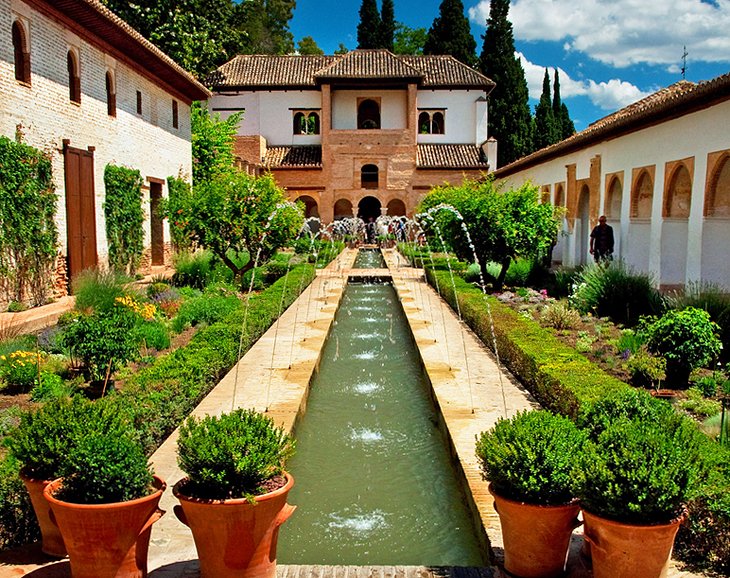
The Palacio del Generalife was the summer palace of the Moorish Kings, which was completed in 1319, during the reign of Ismail I. The Generalife Palace is most renowned for its gorgeous and meticulously landscaped gardens, and strolling the paths around the lush plantings is one of the most popular things to do at the Alhambra.
The beautifully landscaped Alhambra gardens extend up the hill, reminiscent of the gardens of an Italian Renaissance villa with terraces, grottoes, flowerbeds, and carefully trimmed hedges.
The most characteristic feature of the gardens is the use of water in water lanes and decorative fountains. The abundance of water was the Moors' symbol of richness, and the fountains are extravagant showpieces.
From the outer gate at the east end of the Alhambra complex, a cypress-lined avenue leads to the Patio de los Cipreses (Patio of the Cypresses). Shaded by ancient cypress trees, this large courtyard features a pond surrounded by myrtle hedges and another small pond with a fountain.
The most impressive area of Generalife Gardens is the Patio de la Acequia (Patio of the Irrigation Ditch), which is much more romantic than the English translation implies. The courtyard is enclosed by two pavilions and has a water channel dividing it lengthwise. The rest of the courtyard is planted with fragrant orange trees, cypresses, and roses.
How to Make the Most of Your Visit to the Alhambra
- Set Aside a Day: The Alhambra is not a place that you can just pop into and out of and put a checkmark on your list of famous places visited. A visit here takes some planning, the site has multiple attractions contained within.
- Tickets to the Alhambra: Pre-booked tickets to this attraction are required, as the number of daily visitors is limited. Book on the official Alhambra ticket site well ahead of time, ideally several months in advance. Access is controlled via a timed entry system, meaning that you'll need to be in certain places in the complex at certain times. Set aside a half day at a bare minimum.
- Tours of the Alhambra: Avoid the lines and learn fascinating Alhambra facts, including details about its history and architecture, from a knowledgeable guide by taking a Skip the Line: Alhambra and Generalife Gardens Half-Day Tour. This three-hour excursion includes hotel pickup and drop-off and a walking tour that covers the highlights of the Alhambra complex.
- Take a Taxi or Public Transport to the Entry Gate. The Alhambra is located high above Granada and a walk to the top is a minimum of 30 minutes along steep and sometimes confusing roadways and paths. A better option is to walk down after your visit (if you have the energy).
- Visit in the Spring or Fall: A visit in the summer is not recommended, temperatures can frequently soar into the mid-30-degree Celsius range under cloudless skies. If you do, plan to go early and beat the afternoon heat. Only a few vendors sell water and it is exorbitantly expensive.
- Mobility and Fitness are Important: Those with mobility or fitness issues will find a visit here challenging. The ground is uneven, stairs are everywhere, and the place is larger than most first-time visitors are expecting.
- Explore the Gardens: After visiting the Palacios Nazaries, you may visit the other Alhambra palaces and wander the Alhambra grounds at leisure. The grounds are open to the public and do not require a ticket.
- Late-Night Visits: Experience the Alhambra in the evening under the romantic glow of moonlight. The palaces and fountains are illuminated, creating a truly dreamy ambience. Late-night visits are also a solution for those without a pre-booked ticket. Check the official site for details.
- Walk to the Alhambra: Only if you have time and the fitness, consider this option. From the Plaza Nueva, take the beautiful path shaded by ancient trees along the Cuesta de Gomérez. The 250-meter-long path continues to the Puerta de las Granadas, the 16th-century gateway and main entrance to the Alameda. From here, the Cuesta Empedrada climbs up the steep hillside above the gorge through the Alhambra Park. This walk ends up closest to the Alcazaba, a good place to begin discovering the Alhambra (unless you are in a hurry to get to the Palacio Nazaries for your visiting time).
Map of the Alhambra: Top Attractions
More Related Articles on PlanetWare.com

Exploring Spain: While you are in the Andalusia region, be sure to explore some of the Pueblos Blancos (White Villages) of Andalusia where whitewashed hilltop towns grace the rural landscape. For inspiration in planning your complete trip to Spain, see our article on the Top Attractions in Spain.
